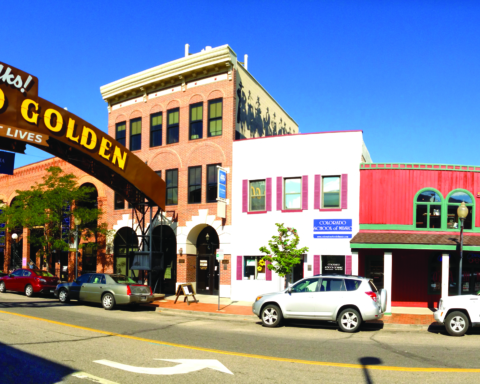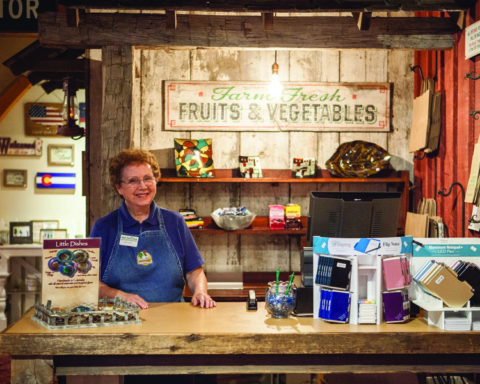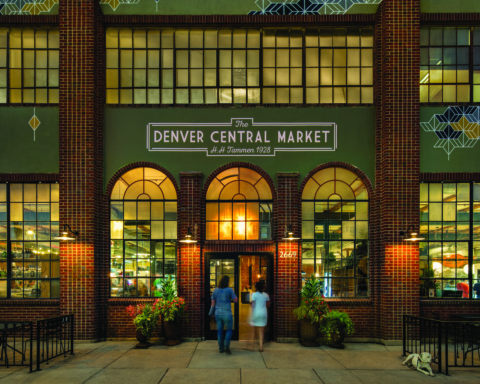Fifteen – Love
Tennis Pro Turned Culinary Icon Richard Sandoval Talks About Food, Flavors and 15 Years of the Denver Restaurant That Started it All

In May, one of Denver’s original Mexican restaurants celebrated its quinceañera. “It seems like it’s been three minutes,” Chef/Owner Richard Sandoval says of his now 15-year-old Tamayo restaurant in Larimer Square. “Time flies by,” he adds. “But to see a restaurant that is 15 years old and having its best year ever is pretty incredible. It’s a tribute to the chefs, the team, the staff. They’ve done an amazing job.”
And that’s how my interview with the world-renowned chef begins — with an immediate nod to his staff and the people supporting him in his restaurants all over the world. He orders us two glasses of water, silences his cell phone, and turns back to me as we sit in the recently renovated Tamayo dining room to talk about his roots, his move to Denver, and his plans for the future.

The Son of A Restaurant Owner Richard Sandoval was born in Mexico City, the son of a restaurant owner and grandson of a banker. His parents divorced when he was very young, and he spent much of his childhood in his grandmother’s kitchen.
“In Latin culture, everything revolves around food,” Sandoval says. He describes vivid memories of watching his grandmother set the long dining room table, routinely hosting 20-25 people each Friday and Saturday. The cooks would emerge from the kitchen with ample platters of traditional Mexican dishes — as well as imported European delicacies — and young Sandoval would take part in all six or seven courses, tasting everything from molé and chimichurri to European butter and nutty Gruyère. “I was very fortunate that, at a young age, I was experiencing and tasting these different ingredients which a lot of kids would never think about tasting,” Sandoval says. “It had a huge impact on my future and my career.” He believes that someone, somewhere, had a plan for him — a plan that would eventually lead him to a career in the culinary world.
At the age of 12, Sandoval went to live with his father who owned an iconic restaurant in Acapulco. Not a chef but a great businessman, Sandoval’s father instilled in him the importance of business sense. “My father was always having long meetings about numbers,” he remembers, laughing. “That stuck with me.”
The budding chef would eventually attend culinary school, but not before pursuing his other passion: tennis. “All I ever thought about throughout high school was tennis,” he says. In his early 20s, Sandoval went on to compete in prestigious matches all over the world. Yet, he eventually realized he wouldn’t make a living playing professionally. “So, I could go back home and teach tennis, orI could choose a different path,” Sandoval recalls.
His passion for food quickly resurfaced and he decided to enter the Culinary Institute of America — although at that time he had no plans to open his own restaurant. “Never!” he laughs. But for the first time, he found himself engaged in the classroom and actively reliving a passion rooted deep in his childhood. His competitive spirit began to burn anew and led him to wonder what might be possible.
After graduation, Sandoval went to work for his father to solidify his skills in restaurant operations. Four years later, he decided it was time. He moved back to New York and opened his first restaurants: the French-inspired Savann and Savann Est.
In 1997, he opened his flagship modern Mexican restaurant in New York, Maya — an homage to his heritage and a veritable game-changer for Mexican cuisine. Five years after that, he opened Tamayo, his first restaurant in Colorado.
Mexican Food Then and Now
When Sandoval began building his dream of introducing Latin and Mexican cuisine to an international audience, he started with Denver — which is much different now than it was in the early 2000s.
“It was much harder get people to understand modern Mexican food at that time. People saw
Mexican food as fast casual or Tex-Mex, not fine dining.” Sandoval would gently insist that fine Mexican cuisine is not so different from fine Italian or French food, only accompanied by crema fresca and chile de árbol instead of crème fraîche and herbes de Provence.
Today, that perception has noticeably changed. “As people are moving into town, you get more ethnic groups, more diversity, more people interested in more diverse restaurants.” Plus, he says, there are more and better chefs in Denver now, and that competition helps everyone grow and improve.
“People are engaging with Mexican food like never before,” Sandoval says. “20 years ago, Mexican wasn’t a global cuisine. Today, you find it all over the world. I feel very proud to have showcased my culture in that way.”
The Move to Denver
Indeed, Sandoval’s early restaurants would lay the foundation for what was to come, namely the launch of his global restaurant group (Richard Sandoval Restaurants), including half a dozen restaurants in Colorado and nearly 40 others around the world.
Through it all, Sandoval has never fully unmoored from his early anchor in the Rocky Mountains. In 2015, he moved his headquarters (and his family) to Denver for good.

“Denver has long been a home to me,” Sandoval says. “When I first opened Tamayo 15 years ago, I was actually in the process of moving here.” He had rented a house in Cherry Creek and even enrolled his young son and daughter in school. But as he was planning the move, more restaurant opportunities emerged which would require him to travel more than expected. He and his then wife decided to move their family to California, while Sandoval kept a simple apartment in Denver. “I’ve always had the most restaurants here, and I’ve always spent the most time here over anywhere else,” he says. “The plan was always to settle down here.”
Since Tamayo opened all those years ago, Sandoval has carved out his own space in the culinary world, anchored by his native Mexican flavors and colored with international influences from Asia, Peru, and Spain. His concepts in Colorado include Zengo, La Sandia, La Biblioteca, Maya in Beaver Creek, and Venga Venga in Snowmass, while his other 40-some restaurants span Arizona, California, Florida, Nevada, New York, Virginia, and Washington, D.C., as well as Dubai, Hong Kong, Mexico, Tokyo, Qatar, and Serbia. His latest include Isla at The Pearl-Qatar and Toro Toro on the private island of Marsa Malaz.
Never-Ending Inspiration
Echoing his days on the tennis court, Sandoval is never one to stand still. New restaurants are opening all the time, like the forthcoming Aqimero in the Ritz-Carlton in Philadelphia along with others coming to Houston’s Four Seasons and Conrad Chicago.
His 10-year-old Denver restaurant, Zengo, also continues to evolve. With a name meaning “give and take back and forth,” in Japanese, Zengo has always represented a dance between Latin and Asian flavors. However, the concept has recently taken on a greater Asian emphasis in its Dubai and D.C. locations, and an imminent fall remodel to the Denver mainstay will reflect that shift here, too.
Sandoval is keenly aware of other changing trends in the culinary world. “Fine dining has taken a drastic left turn,” he says. “You see very few restaurants with white tablecloths anymore. These days, people are much more interested in sharing and having a more interactive experience.” Case in point: the menu at Tamayo was classically structured into appetizers and entrées for years. Now, it’s more of a sharing menu with ever-evolving starters, enchiladas, and chef-driven test kitchen items. Specials like $39 Bottomless Margarita Brunch don’t hurt, either.

Photo by Marc Piscotty
Tamayo’s new urban ambience also defies former expectations. “Mexican restaurants 20 years ago had iconic arches and colorful piñatas,” Sandoval says. “People expected them to have a certain look.” Today, Tamayo is urban, upscale, and trendy with dark woods brightened by floor-to-ceiling windows. Next year, Sandoval plans to remodel the rooftop, which he calls “one of the most beautiful spaces in Denver.”
As we wrap up our interview, I ask Sandoval what inspires him now, two decades since his childhood passion first drove him to open Maya and Tamayo.
“Oh, it’s still the food,” he says emphatically. “When I opened Maya, I wanted to show people that Mexican food was not just burritos and combination plates. And now 20 years later, I think I’ve accomplished that.”
Monica Parpal Stockbridge
Monica Stockbridge is a Denver-based writer and editor who has covered the food and dining scene for publications like DiningOut magazine and Moon travel guidebooks. As a contributing writer for Colorado Hotel Magazine, Monica writes chef profiles and hotel stories that reveal inspiring mile-high experiences for visitors and locals alike.







